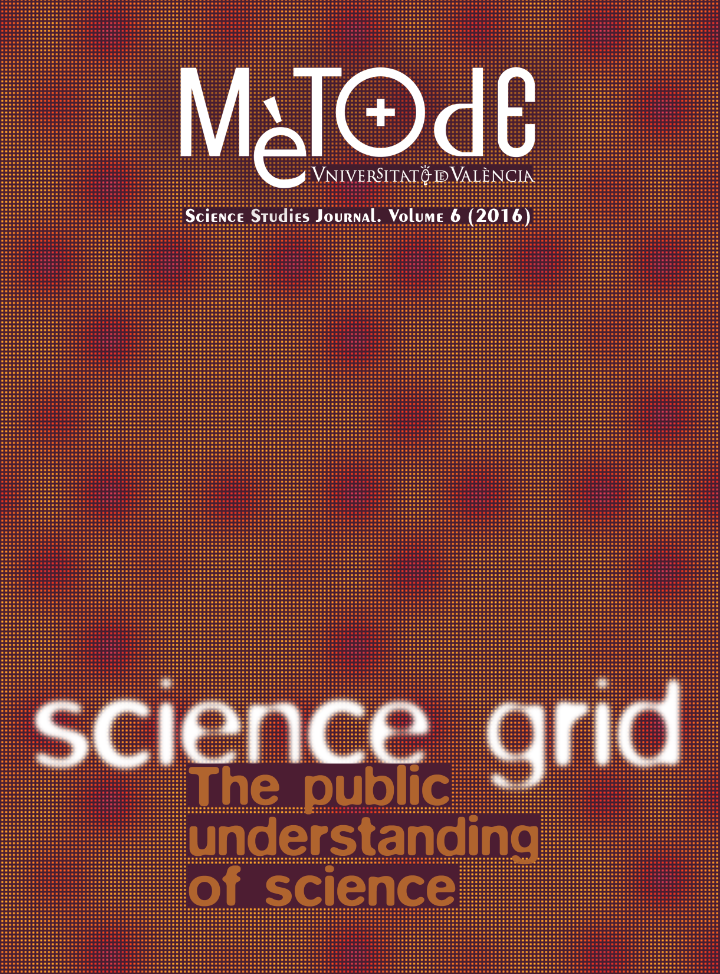The debate on rare diseases: A look at media response
DOI:
https://doi.org/10.7203/metode.6.7188Keywords:
critical discourse analysis, rare diseases, means of communication, argumentation, orphan drugs Abstract
Abstract
Rare diseases (RDs) are thosethat affect fewer than five people in every 10,000. There are around 7,000 RDs, they are difficult to diagnose and very few have a treatment. This article explores how the media report on the arguments and counter-arguments regarding the access to drugs for these pathologies, with critical discourse analysis for the case of Duchenne muscular dystrophy. We concluded that, in times of crisis, the debate polarises around economic arguments (the price of drugs), reinforced by doubts about their healing effectiveness.
 Downloads
Downloads
 References
References
Armayones, M., Requena, S., Gómez, B., Pousada, M., & Bañón, A. M. (2015). El uso de Facebook en asociaciones españolas de enfermedades raras: ¿Cómo y para qué lo utilizan? Gaceta Sanitaria, 29(5), 335–350. doi: 10.1016/j.gaceta.2015.05.007
Bañón, A. M., Fornieles, J., Solves, J. A., & Rius, I. (Coords.). (2011). Desafíos y estrategias comunicativas de las enfermedades raras. La investigación médica como referente. Valencia: CIBERER.
Bengoa, A. (2015, 15 August). Sydney ya tiene la medicina para frenar la enfermedad. El País. Retrieved from http://politica.elpais.com/politica/2015/08/14/actualidad/1439564446_804178.html
Bengoa, A., & Sevillano, E. G. (2015a, 11 August). Mi hijo tendría el tratamiento adecuado fuera de Madrid. El País. Retrieved from http://ccaa.elpais.com/ccaa/2015/08/10/madrid/1439240131_518758.html
Bengoa, A., & Sevillano, E. G. (2015b, 12 August). La Comunidad promete ahora tratar al niño con síndrome de Duchenne. El País, p. 3.
Budych, K., Helms, T. M., & Schultz, C. (2012). How do patients with rare diseases experience the medical encounter? Exploring role behavior and its impact on patient-physician interaction. Health Policy, 105(2–3), 154–164.
Comunidad de Madrid. (2015, 13 August). El niño con síndrome de Duchenne inicia hoy su tratamiento. Comunidad de Madrid. Retrieved from http://www.madrid.org/cs/Satellite?c=CM_Actualidad_FA&cid=1354515183117&language=es&pagename=ComunidadMadrid%2FEstructura
Cutillas, P., & Serrano, M. (2015, 11 August). Noticias La Sexta. [Television broadcast]. Madrid, Spain: La Sexta TV. Retrieved from http://www.lasexta.com/noticias/sociedad/reclaman-comunidad-madrid-que-medicacion-sidney-nino-anos-que-sufre-distrofia-muscular-duchenne_2015081100115.html
Douglas, C., Wilcox, E., Burgess, M., & Lynd, L. (2015). Why orphan drug coverage reimbursement decision-making needs patient and public involvement. Health Policy, 119, 588–596. doi: 10.1016/j.healthpol.2015.01.009
Efe. (2015, 14 August). Los padres del niño que sufre Duchenne ya tienen el medicamento para su hijo. Efe. Retrieved from http://www.efe.com/efe/espana/sociedad/los-padres-del-nino-que-sufre-duchenne-ya-tienen-el-medicamento-para-su-hijo/10004-2688235
Federación Española de Enfermedades Raras. (2009). Estudio sobre situación de necesidades sociosanitarias de las personas con enfermedades raras en España. Estudio ENSERio. Madrid: Caja Madrid.
Graf, J. M., & Frank, M. (2015). Rare is frequent and frequent is costly: Rare diseases as a challenge for health care systems. European Journal of Health Economics, 16, 113–118. doi: 10.1007/s10198-014-0639-8
Kesselheim, A., McGraw, S., Thompson, L., O’Keefe, K., & Gagne, J. (2015). Development and use of new therapeutics for rare diseases: Views from patients, caregivers, and advocates. Patient, 8, 75–84. doi: 10.1007/s40271-014-0096-6
Luzzatto, L., Hollak, C. E. M., Cox, T. M., Schieppati, A., Licht, C., Kääriäinen, H., & Remuzzi, G. (2015). Rare diseases and effective treatments: Are we delivering? The Lancet, 385(9970), 750–752. doi: 10.1016/S0140-6736(15)60297-5
Marqués, J. (2015, 28 July). La Sanidad está atendiendo a 185.000 inmigrantes como a cualquier español. El economista. Retrieved from http://www.eleconomista.es/interstitial/volver/fords15/sanidad/noticias/6900297/07/15/La-Sanidad-esta-atendiendo-a-185000-inmigrantes-como-a-cualquier-espanol.html#.Kku8Z1j7O01EZEH
Picavet, E., Annemans, L., Cleemput, I., Cassiman, D., & Simoens, S. (2012). Market uptake of orphan drugs – a European analysis. Journal of Clinical Pharmacy and Therapeutics, 37, 664–667. doi: 10.1111/j.1365-2710.2012.01364.x
Picavet, E., Cassiman, D., & Simoens, S. (2014). Reimbursement of orphan drugs in Belgium: What (else) matters? Orphanet Journal of Rare Diseases, 9, 139. doi: 10.1186/s13023-014-0139-z
Rombach, S., Hollak, C. E. M., Linthorst, G., & Dijkgraaf, M. G. W. (2013). Cost-effectiveness of enzyme replacement therapy for fabry disease. Orphanet Journal of Rare Diseases, 8(1), 29. doi: 10.1186/1750-1172-8-29
Schlander, M., & Beck, M. (2009). Expensive drugs for rare disorders: To treat or not to treat? The case of enzyme replacement therapy for mucopolysaccharidosis VI. Current Medical Research and Opinion, 25(5), 1285–1293. doi: 10.1185/03007990902892633
Solves, J., Bañón, A., & Rius, I. (2015). El OBSER como centro impulsor de la investigación social de las enfermedades minoritarias. In C. Peñafiel, & J. L. Terrón (Coords.), Estudios de comunicación y salud (pp. 131–156). Tenerife: Cuadernos Artesanos de Comunicación.
The Lancet. (2015). Reducing the cost of rare disease drugs. The Lancet, 385(9970), 746. doi: 10.1016/S0140-6736(15)60420-2
Downloads
Published
How to Cite
-
Abstract1133
-
PDF398
Issue
Section
License
![]()
All the documents in the OJS platform are open access and property of their respective authors.
Authors publishing in the journal agree to the following terms:
- Authors keep the rights and guarantee Metode Science Studies Journal the right to be the first publication of the document, licensed under a Creative Commons Attribution-NonCommercial-NoDerivatives 4.0 International License that allows others to share the work with an acknowledgement of authorship and publication in the journal.
- Authors are allowed and encouraged to spread their work through electronic means using personal or institutional websites (institutional open archives, personal websites or professional and academic networks profiles) once the text has been published.





